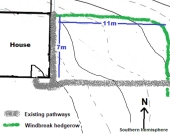Cat Hargreaves wrote:What did others do in the old days? Can I get root cellar conditions with something built above ground with an earth berm over it?
In the old days, people preserved meats via, salt, oil, canning, smoking, etc (ever hear of pemmican? It’s pretty cool stuff and well worth reading about). Sausage, smoked hams, salted fish, some of that old school stuff is both fun/cool and very delicious. Sometimes, they kept the meat safe and fresh by keeping the animal alive until they were ready to eat it, (if they didn’t live in a climate cold enough to keep it frozen). And with global warming getting worse... Well let’s just say that in the not too distant future, someone is gonna be selling ice to Eskimos

I grew up on an organic farm on Orcas Island, we had a root cellar, and that did a great job for storing fruits and veggies, but you would be crazy (and suicidal) if you tried to store meat in it. We used freezers for storing meats.
You can find a ton of info in books or by just using Google to find out safe temps and conditions for safe meat storage as well as preservation methods, recipes, how to videos, etc. There is a ton of complexity and variables to meat storage and preservation. It might help you solve the puzzle if you find out what some of those safe temp ranges and humidity levels are for your particular desire/application. Good luck!!!






